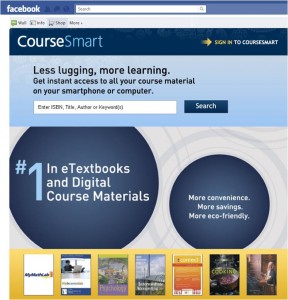 Having access to digital course materials is increasing in popularity, with new tools and applications emerging to fill different instructional needs. In addition to providing access to eTextbooks, these systems include a variety of functions that allow students and instructors to interact with the materials and each other. Institutions, instructors, and students are all potential users of these new tools, which include features such as annotation and highlighting, collaboration with classmates, supplemental materials and multimedia, and learning management system integration.
Having access to digital course materials is increasing in popularity, with new tools and applications emerging to fill different instructional needs. In addition to providing access to eTextbooks, these systems include a variety of functions that allow students and instructors to interact with the materials and each other. Institutions, instructors, and students are all potential users of these new tools, which include features such as annotation and highlighting, collaboration with classmates, supplemental materials and multimedia, and learning management system integration.
CourseSmart, with multiple partners in education publishing, is just one of the new options out there, and one that I have referenced in previous posts about trends in college textbooks. Beyond the products avalable, the organization is also involved in research about student use of and preferences for technology at high school and college levels.
Jill Ambrose, Chief Marketing Officer for CourseSmart, graciously made time for some questions about the products and services available. She joined the CourseSmart team with an interest in "the opportunity to create equal and affordable access to educational content anywhere and anytime." Ambrose states that CourseSmart's mission "is to connect content producers (publishers) with content users (students, faculty, institutions) in the higher education space in order to offer the most comprehensive learning experience possible and at a great value." I asked for more information from her perspective on the industry and the future of online learning, as well as how CourseSmart is making an impact both with students and instructors and in the eLearning marketplace.
What's the biggest challenge facing the online delivery of higher education right now?
The landscape of education is rapidly changing and evolving every day. Increased economic pressures, access to education, as well as time constraints that both faculty and students face, are real issues that need to be addressed.
Additionally, education is not "one size fits all" and students have unique situations and different needs that should be recognized and met accordingly in order for them to have the most successful possible experience. Today's students – the future leaders of society – deserve to have resolution to these issues so that they can succeed.
It is critically important that players in the education space recognize these challenges and adapt quickly. As it relates to the online delivery of educational content, affordability, accessibility, mobility, productivity and the improvement in learning outcomes are solutions to some of these problems.
You recently conducted a research study that explored student views about technology. What are the biggest takeaways from this project?
Well, I think first and foremost, the commissioned research study (which compared study and communication preferences of today's high school and college students) supported the idea on which we base our mission at CourseSmart, and that not only are today's students incredibly tech-savvy, but that they crave stimulating, interactive learning environments that enhance their overall learning experiences. Technology helps to drive that experience.
It's a pretty remarkable statistic that 76 percent of high school students and 79 percent of college students say it would be appealing if a college offered a classroom experience where students can ask professors questions through social networking sites like Twitter. This idea further reinforces the idea that today's high school and college students are digital natives and that they view technology as a natural part of the way they interact with others, including those in the education space.
Another takeaway from the study is that today's students concern themselves with the cost of college at an earlier age than ever, with 13 percent of high school students claiming they began looking into financing their college education in junior high, as opposed to 6 percent of college students who claim to have done the same. As financial concerns affect students at earlier ages, the value and importance they place on a college education is at a new premium, especially when it comes to course materials and other associated items, which they can control. Many students view eTextbooks as a money-saver and are increasingly willing and more likely to invest in a tablet or other device that allows them to maximize their budget for the duration of their college experience.
Overall, what we have seen through this research is that the gap between high school and college students' study preferences and habits is closing. High school students are increasingly open to and expecting the same types of interactive learning materials that college students have already been exposed to, and both groups are constantly looking ahead and embracing the future that is digital educational supplements.
How does CourseSmart differ from other eTextbook products and services?
 CourseSmart fills the role of connecting publishing companies with content users, including students, faculty and institutions, at the lowest cost possible in an effort to increase access to course materials they need to succeed.CourseSmart is unique in the eTextbook marketplace for several key reasons:
CourseSmart fills the role of connecting publishing companies with content users, including students, faculty and institutions, at the lowest cost possible in an effort to increase access to course materials they need to succeed.CourseSmart is unique in the eTextbook marketplace for several key reasons:
- Content: CourseSmart's catalog includes more than 20,000 eTextbooks and represents 90% of all core higher education textbooks in use today – the world's largest provider.
- Price: Upfront savings of up to 60% when compared to new print textbooks.
- Device Agnostic: Students can access their eTextbooks from any Web-enabled device and through CourseSmart's Android OS-based, iOS, and mobile Web apps.
- Page Fidelity: CourseSmart eTextbooks mirror the experience of the print version of the textbook through page fidelity; ensuring students are literally on the same page as instructors and classmates that may be using print alternatives.
- Accessibility: 80% of CourseSmart's top selling titles have been optimized to be fully accessible for instructors and students with print related disabilities.
- Markets: CourseSmart is the only course materials provider that serves 4 key markets, including students, faculty, bookstores and institutions.
Following eBook Trends
To find out more about CourseSmart, take a look at the website and find them on Facebook and Twitter. You can also sign up for a trial version of any eTextbook to experience the system for yourself. And to follow the latest developments in eBooks and digital texts, take a closer look at the eBook resources from EDUCAUSE and reviews provided on sites like MindShift.
Share Your Perspective
Have you used eTextbooks in your online courses? We'd like to hear more about your experiences, as online students and instructors, with digital books and comprehensive digital course material systems like CourseSmart.